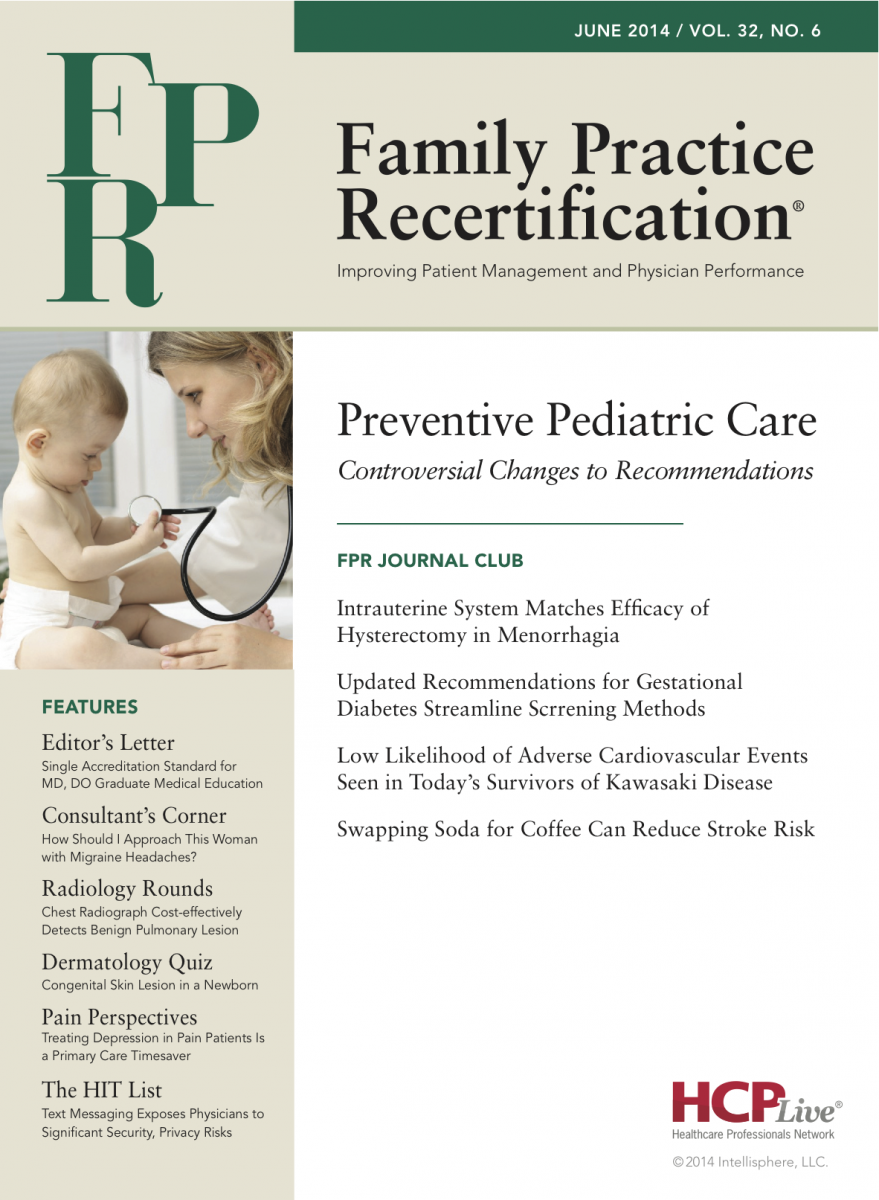Publication
Article
Family Practice Recertification
Updated Recommendations for Gestational Diabetes Streamline Screening Methods
Author(s):
In response to the growing prevalence of gestational diabetes mellitus and its associated morbidities, much attention has been paid to the use of appropriate screening methodologies for the metabolic disorder.
Review
Moyer VA, US Preventive Services Task Force. Screening for gestational diabetes mellitus: US Preventive Services Task Force recommendation statement. Ann Intern Med. 2014;160(6):414-20. http://annals.org/article.aspx?articleid=1813285.
This report updated the 2008 US Preventive Services Task Force (USPSTF) recommendations for gestational diabetes mellitus (GDM) screening, which had cited insufficient evidence to recommend such screening in asymptomatic pregnant women before and after 24 weeks of gestation.
Study Methods
The USPSTF commissioned a literature review to assess the accuracy of various screening tests used to detect GDM, the effect of screening before and after 24 weeks of gestation, and the impact of treatment on maternal and infant outcomes. To establish the effectiveness of early detection and treatment, the review authors examined randomized controlled trials (RCTs) and retrospective cohort studies that explored a wide range of outcomes, including incidence of detected preeclampsia, shoulder dystocia, fetal macrosomia, and maternal anxiety and depression.
Results and Outcomes
Accuracy of Screening
The USPSTF concluded primary care providers (PCPs) can accurately detect GDM in asymptomatic pregnant women between 24-28 weeks of gestation using one of the methods below.
The agency endorsed 2 GDM screening methods:
- Two-step approach recommended by the American College of Obstetricians and Gynecologists (ACOG), where a 50-gram glucose load is administered in a nonfasting state. If the screening threshold is met or exceeded, then the patient takes a 3-hour, 100-gram oral glucose tolerance test.
- One-step, 2-hour approach recommended by the American Diabetes Association (ADA), where a 75-gram glucose load is administered after fasting, and plasma glucose levels are measured at 1 and 2 hours. If any glucose measurement falls at or above the specified thresholds, then GDM is diagnosed.
The USPSTF found inadequate data to support the use of other GDM screening modalities.
Benefits of Detection and Early Treatment
The committee found treatment for screen-detected GDM consisting of dietary modification, glucose monitoring, and insulin or oral hypoglycemic agents on an as-needed basis reduces the risk of preeclampsia, fetal macrosomia, and shoulder dystocia.
Harms of Detection and Early Treatment
According to the USPSTF, the benefits of GDM screening and treatment outweigh the risk of associated harms. Specifically, the incidence of Cesarean delivery and neonatal intensive care unit admissions are statistically equivalent between women who are and are not treated for GDM.
The data on induction of labor and other neonatal outcomes are less clear, but they suggest treatment does not result in poor outcomes. Although anxiety issues and screening costs were not fully evaluated by the USPSTF, they should be considered potential challenges.
Conclusion
The USPSTF committee found screening for GDM after 24 weeks of gestation moderately reduced maternal and fetal complications — specifically, the incidence of preeclampsia, macrosomia, and shoulder dystocia — but it found insufficient data to support such screening prior to that time interval.
Commentary
The normal physiologic changes of pregnancy involve increased insulin resistance resulting from placental production of various hormones, but when pancreatic function is not sufficient enough to adapt, GDM develops.1 Although the screening modalities for GDM reviewed in this report are not diagnostic, they can be used to predict the likelihood of a positive follow-up diagnostic test.
In the ACOG’s nonfasting 2-step method, a positive result is controversial, but it is commonly accepted as >130-140 mg/dL.2 If the patient’s glucose level exceeds this limit, then a 3-hour, 100-gram fasting test is obtained using cut-points of ≥95 mg/dL at fasting, ≥180 mg/dL at one hour, ≥155 mg/dL at 2 hours, and ≥140 mg/dL at 3 hours. In the ADA’s fasting one-step method, GDM is diagnosed when the fasting glucose is ≥126 mg/dL or the 2-hour glucose measurement is ≥200 mg/dL.
While evidence supports the use of GDM screening during pregnancy, some arguments have been made against this practice, the reasons for which include increased healthcare costs, maternal psychological stress, and concerns about the added risks of iatrogenic adverse events or increased medical interventions, such as the possible induction of labor, cesarean delivery, and infant admission to a neonatal intensive care unit. Additionally, many women find the glucose beverage consumed during screening intolerable.
Though the benefits of GDM screening and treatment outweigh the potential risks, those harms can include neonatal or maternal hypoglycemia. In addition, the lack of a uniform diagnostic approach and criteria for GDM makes it difficult to compare outcome data across populations and raises uncertainty about the conclusions drawn from clinical studies.
It has been well established that GDM is associated with maternal risks like preeclampsia and fetal complications like neonatal hypoglycemia. In response to the growing prevalence of GDM and its associated morbidities, much attention has paid to the use of appropriate screening methodologies for the metabolic disorder. The USPSTF recommendation to support GDM screening via OGCT after 24 weeks makes good sense and will hopefully produce better perinatal outcomes.
References
1. Coustan DR, Jovanovic L. Screening for and diagnosis of diabetes mellitus in pregnancy. In: UpToDate, Barss V (Ed), UpToDate, Waltham, MA. (Accessed on March 28, 2014.)
2. Donovan L, et al. Screening tests for gestational diabetes: a systematic review for the U.S. Preventive Services Task Force. Ann Intern Med. 2013;159(2):115-22. http://annals.org/article.aspx?articleid=1691699.
About the Authors
Kristin Gerson, MD, is a resident physician in obstetrics and gynecology at Beth Israel Deaconess Medical Center and a recent graduate of the University of Massachusetts Medical School (UMMS) in Worcester, MA.
She was assisted in writing this article by Frank J. Domino, MD, Professor and Pre-Doctoral Education Director for the Department of Family Medicine and Community Health at UMMS and Editor-in-Chief of the 5-Minute Clinical Consult series (Lippincott Williams & Wilkins).





